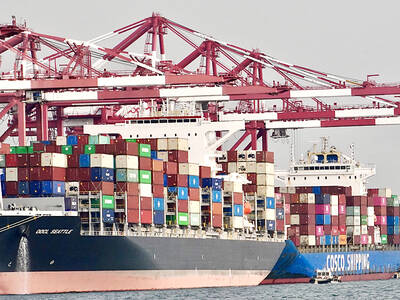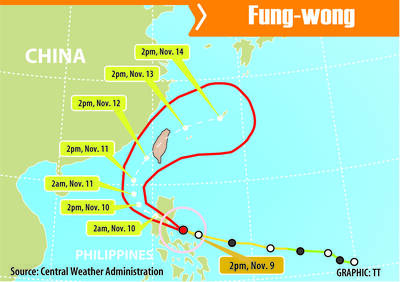China’s unilateral decision to allow flights to operate on its self-drawn M503, W122 and W123 flight routes without adjustment changes the “status quo” of the Taiwan Strait and puts flights to the outlying islands of Kinmen and Lienchiang (Matsu) counties at greater risk, government officials said yesterday.
An agreement signed by Beijing and Taipei in March 2015 stipulated that only southbound flights were allowed on the M503 route, and the flights must operate 6 nautical miles (11.11km) west of the route. The agreement also required flights on the route to veer to the west if they encountered emergency situations, while the W121, W122 and W123 routes would not be launched until after both sides confirmed the details of their implementation.
Beijing first broke the agreement on Jan. 4, 2018, when it announced that northbound flights would be allowed on M503, while westbound flights would be permitted on W121, W122 and W123.

China on Tuesday said that all flights on M503 do not need to operate 6 nautical miles west of the route, adding that eastbound flights would be allowed on W122 and W123.
“The Chinese government ignored the agreement that both sides reached in 2015, and the unilateral move would severely affect aviation safety across the Taiwan Strait. The ploy, along with increasingly frequent flights of high-altitude balloons in Taiwan’s airspace, are designed to destroy the peace and stability across the Strait. We strongly condemn such inappropriate action,” Premier Chen Chien-jen (陳建仁) told reporters during a visit to the Taipei Flower Market (台北花卉產銷).
Civil aviation and national security officials are deliberating over proper responses to the move, Chen said.
The Civil Aviation Administration (CAA) in a statement said that Beijing’s decision in 2018 has already complicated air control operations on the west side of the Taipei Flight Information Region (FIR) and in the airspace around Kinmen and Matsu, adding that its decision yesterday has further complicated air traffic control in the areas.
“Such an irresponsible move not only adversely affects the aviation safety of flights to Kinmen and Matsu, but it also elevates risks for other flights passing through the region. China must be held responsible for all the possible consequences of its action,” it said.
Under International Civil Aviation Organization guidelines, China must negotiate with all stakeholders along its flight routes should it seek to adjust them, the CAA said.
Taiwan and China must address safety issues involved with changes to the M503, W122 and W123 routes, given that M503’s closest point to the Taipei FIR is only 4.2 nautical miles, while W122 is only 2.8 nautical miles from the south terminal airspace of Matsu, it said.
The narrowest buffer zone between W123 and Kinmen’s airspace is 1.1 nautical miles, it added.
“We strongly protest China’s unilateral changes to the use of the three flight routes and demand that both sides negotiate a resolution as quickly as possible,” the agency said. “Air traffic controllers in Taipei, Kinmen and Matsu will closely monitor the flights operating within these areas and demand that Chinese air traffic controllers guide Chinese aircraft away from Taiwan’s airspace.”
Ministry of National Defense spokesman Sun Li-fang (孫立方) also called China’s unilateral move “irrational” and “destructive,” as it could easily escalate the tension and destroy stability in the region.
“The military would continue to monitor the situation around Taiwan through our joint intelligence, surveillance and reconnaissance operations, and handle unidentified flying objects intruding upon our air defense identification zone in accordance with our standard procedures,” Sun said.
The Ministry of Foreign Affairs also urged the international community to demand China negotiate with Taiwan over the changes.

The Central Weather Administration (CWA) yesterday said it expected to issue a sea warning for Typhoon Fung-Wong tomorrow, which it said would possibly make landfall near central Taiwan. As of 2am yesterday, Fung-Wong was about 1,760km southeast of Oluanpi (鵝鑾鼻), Taiwan’s southernmost point, moving west-northwest at 26kph. It is forecast to reach Luzon in the northern Philippines by tomorrow, the CWA said. After entering the South China Sea, Typhoon Fung-Wong is likely to turn northward toward Taiwan, CWA forecaster Chang Chun-yao (張峻堯) said, adding that it would likely make landfall near central Taiwan. The CWA expects to issue a land

Taiwan’s exports soared to an all-time high of US$61.8 billion last month, surging 49.7 percent from a year earlier, as the global frenzy for artificial intelligence (AI) applications and new consumer electronics powered shipments of high-tech goods, the Ministry of Finance said yesterday. It was the first time exports had exceeded the US$60 billion mark, fueled by the global boom in AI development that has significantly boosted Taiwanese companies across the international supply chain, Department of Statistics Director-General Beatrice Tsai (蔡美娜) told a media briefing. “There is a consensus among major AI players that the upcycle is still in its early stage,”

The Central Weather Administration (CWA) yesterday said it is expected to issue a sea warning for Typhoon Fung-wong this afternoon and a land warning tomorrow. As of 1pm, the storm was about 1,070km southeast of Oluanpi (鵝鑾鼻), Taiwan’s southernmost point, and was moving west-northwest at 28 to 32kph, according to CWA data. The storm had a radius of 250km, with maximum sustained winds of 173kph and gusts reaching 209kph, the CWA added. The storm is forecast to pass near Luzon in the Philippines before entering the South China Sea and potentially turning northward toward Taiwan, the CWA said. CWA forecaster Chang Chun-yao (張峻堯) said

‘SECRETS’: While saying China would not attack during his presidency, Donald Trump declined to say how Washington would respond if Beijing were to take military action US President Donald Trump said that China would not take military action against Taiwan while he is president, as the Chinese leaders “know the consequences.” Trump made the statement during an interview on CBS’ 60 Minutes program that aired on Sunday, a few days after his meeting with Chinese President Xi Jinping (習近平) in South Korea. “He [Xi] has openly said, and his people have openly said at meetings, ‘we would never do anything while President Trump is president,’ because they know the consequences,” Trump said in the interview. However, he repeatedly declined to say exactly how Washington would respond in